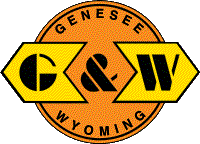| Back to History Page |
 |
This page is devoted to some of the many historical articles about railroading in the Western New York area. This installment was written by the Genesee & Wyoming Railroad corporate offices as it appeared in their 1983 brochure. As more articles are added, old ones will be archived on our history page. So sit back, or feel free to print out, and enjoy the rich railway heritage of Western New York. |
 |
The G&W "A Great Little Railroad" G&W Industries Inc. 1983 |
| The 1859 discovery of oil in Pennsylvania encouraged others to search for deposits of this natural resource in Western New York. A team drilling in the Genesee Valley in 1818 found instead a large deposit of rock salt. When Carrol Coker, an amateur geologist, learned of the discovery, he convinced William Foster, a Western New York financier, to invest in his venture. with Foster's money, a mine was opened and developed in the vicinity of what is recognized as the largest rock salt deposit in the free world. In the early 1890's a small community sprang up around the entrance of the salt mine and was named Retsof (William Foster's name spelled backwards) in honor of the man who had invested in its future. As Livingston County's salt industry grew, getting its product to market was a problem. There were railroad lines in the area, but a connecting link with Retsof was needed. With this thought in mind, the "Genesee & Wyoming Valley" railroad was organized and incorporated in 1891. Its first stretch of railroad tracks , known as the east branch, ran from the mine to Retsof and connected with the Western New York and Pennsylvania Railway company, later called the Rochester - Hinsdale, New York branch of the Pennsylvania Railroad. A connection with the Delaware, Lackawanna and Western Railroad was made when the Genesee and Wyoming Valley Railroad purchased a right of way and extended it’s tracks from Retsof to Greigsville. in 1894. It connected with the Lehigh Valley Railroad and the Buffalo, Rochester and Pittsburgh Railway, later called the Rochester-East Salamanca branch of the Baltimore and Ohio Buffalo division. By April 1st, 1895, the Genesee and Wyoming Valley railroad was hauling rock salt from Retsof to four interchange points on six different railroads. The salt mine by then had been purchased by the Fuller family of Scranton, Pennsylvania, which also wanted to control the railroad. When the salt mine was temporarily closed, the Genesee and Wyoming Valley railroad went into receivership. Since a Fuller associate was the receiver, the bankrupt railroad was purchased for the family he represented. On March 24th, 1899, the reorganized "Genesee & Wyoming Railroad" was established and has been in operation ever since. By the early 1900s all of the company's main line extensions had been completed and connected with six railroads. To improve its service to the citizens and industries of the area, the G&W added nine steam engines and one passenger coach to its holdings. |
| The G&W also operated passenger trains until December, 1929, which ran from Retsof and connected with other rail lines. Over the years the emergence of other forms of transportation, national and international events, technological changes and other factors have had a major effect on railroads. About three decades ago, coal-burning locomotives were replaced by diesel-powered equipment. While the average capacity of flat bottomed gondolas, box cars, and covered hoppers was increased considerably. With the development of bigger engines and cars that carried heavier payloads, the line's roadbed, too, had to be upgraded. Bridges were reconditioned and strengthened, while two trestles (at York Center and Inverness) were eliminated in an effort to make the line straighter. The primary purpose of the G&W is to move rock salt from the Retsof mine to interchange points, for the salt is shipped not only to chemical plants in the Niagara-Falls-Buffalo area and the eastern coast, but also since it is used by highway departments for melting snow and ice, to other points throughout the country. By 1970 it had a fleet of 99 boxcars and 192 covered hoppers for a total of 291 freight cars bearing the distinctive orange and black bull’s-eye mark of the G&W. The pride of the fleet, were the covered hopper and dry bulk cars, that could carry 100 tons of salt. The all-aluminum cars are ideal for transporting salt and other dry bulk commodities, for they need no painting, no lining and build up their own resistance through oxidation. A shop facility, adjacent to the engine house t was built in the late 1960’s to repair and rebuild rail equipment. Added in the late 1970’s, was a sand blasting and painting facility. A diner-lounge car was purchased and converted into an office. The G&W operating from two locations (an executive office at Charles Summit, Pennsylvania, and the general office at Retsof), also purchased two 1,500-horsepower locomotives at a cost of $600,000 & $800,000 for its fleet of about 600 cars. In addition, it bought an old Conrail line, 13.5 miles of track from Greigsville to Groveland. Now computerized, it provides service to many Genesee Valley industrial and agricultural customers. Today, the G&W railroad is one of four operating subsidiaries of Genesee & Wyoming Industries, Inc., a holding company which also includes the GWI Leasing Corporation, an owner and lessor of railroad locomotives and freight cars; GWI Rail Management Corporation, a rail service consultant and contract manager of short line railroads and freight cars; and GWI Data Services, inc., an EOP sales and service company. A single-purpose railroad that has developed into a diversified rail transportation company, the G&W has been rated by an independent study as one of the best managed short line railroads in the United States. over the years it has contributed significantly to the history and economy of Livingston County. |
| In 1977, Genesee & Wyoming Industries Inc., was established as a holding company for four operating subsidiaries: The Genesee & Wyoming Railroad company, an operating railroad and rail equipment contract repair facility; GWI Leasing Corporation, an owner and lessor of railroad freight cars and locomotives building and on fleet management. Today GWI’s fleet includes nearly 1,200 freight cars, principally covered hoppers and 10 locomotives. Approximately half of these cars are leased to shippers on long term and short-term operating leases. In conjunction with its leasing activities, GWI provides professional freight car fleet management and administrative services as an agent for shippers and car owners. Also, the operations and maintenance experience of G&W Railroad personal.GWI Rail Management Corporation, a rail service consultant and contract manager of short line railroads and freight cars. GWI’s experience in short line management and consulting has led it through every sort of operating problem including organizing new railroads, staffing them, obtaining financing, negotiating equitable divisions, establishing marketing and industrial development activities, optimizing rate structures and filling equipment needs. GWI Data Services Inc, and EDP Sales and Service company established to design a data processing system that answers the practical needs of short line railroads, shippers and private car fleet managers. GWI’s successful experience with this equipment and the programs developed for it, induced the company to make these services available commercially through this subsidiary. The unique interaction among these subsidiaries and their personnel is the factor which contributes most to the success and ability to serve the customer. This interaction provides a broad perspective on rail transportation problems. In 1983, the G&W acquired an additional 14 miles of rail line, doubling its size, between Greigsville and Groveland. This rail line was scheduled for abandonment by its owner, Consolidated Rail Corporation. This acquisition assured continued rail service to all those customers along the line. We now interchange freight at Groveland with the Dansville & Mt. Morris Railroad at Greigsville with the Delaware & Hudson Railway and Conrail and at Caledonia with Conrail and the Chessie System. In early 1982, the G&W made a substantial investment to upgrade and modernize its freight car repair facilities in Retsof by installing a steel grit blast recovery system to replace a less efficient sand blast operation and rehabilitated its paint shop to modern standards. The objective being to establish a unique rail freight car repair facility in the Northeast.The blast and paint facilities are used primarily for blasting and painting the interior and exterior of railroad freight cars although recently we have been marketing this service to industrial, commercial, agricultural and highway users in the area with a lot of success. Our repair shop in Retsof performs all types of minor and major repairs, rebuilding work, fabricating, mobile field inspections as well as blasting and painting of cars. We also maintain and overhaul our own locomotives. Our car repair experience is based on cars used principally to carry salt. Due to the density and corrosiveness of salt, it is one of the most damaging commodities to rail equipment. Under these conditions, extra attention must be paid to maintenance to keep operating costs down and assure long life. This same concern and extra attention is, in fact, a tradition of the Retsof work force which outside contract customers have come to appreciate. Outside contract repair work has increased significantly in each of the past few years. |
| For an updated look at how the Genesee & Wyoming Railroad Inc., has grown since 1983, take a look at "Hawkings Rails - G&W", for a in depth looks on its many subsidiaries. They also have many fabulous photos of their locomotives. |
| Back to History Page |
Web Site Hosting by TRAIN WEB
The WNYRHS, Inc., 100 Lee Street, Buffalo, NY. 14210 is an independent organization and has no affiliation with any other local or national group.
The Society is a fully qualified organization under 501 (C) (3) of the Internal Revenue Code and all donations to the Society are tax deductible.
©Copyright 1999 , WNYRHS Inc. all rights reserved